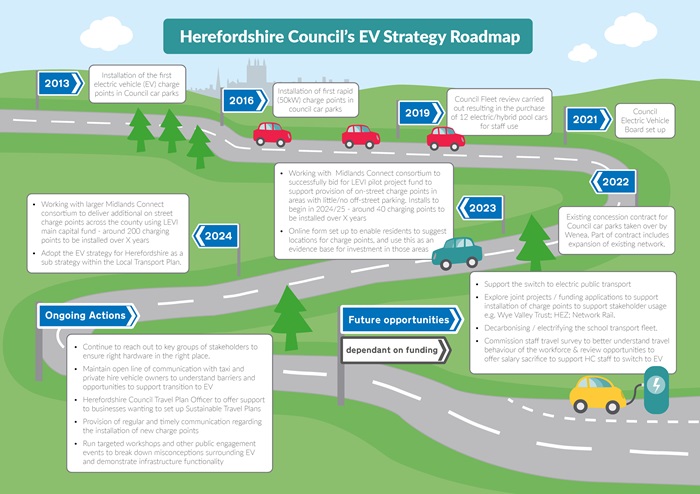Electric vehicle strategy
In May 2024, we adopted our electric vehicle (EV) strategy for Herefordshire. This strategy seeks to address current barriers while supporting the widespread transition to electric vehicles.
The percentage of EV ownership is increasing, and will continue to increase, but the lack of charging infrastructure is one of the barriers causing some groups of drivers to delay making the switch.
As of October 2023, there were 83 public chargepoints available in Herefordshire. However, it is predicted that 1,416 chargers will be required by 2030 – a significant increase on current provision within the county. The EV strategy sets out how the council will help address this issue.
Electric vehicle roadmap

View a larger version of the electric vehicle roadmap
Electric vehicle roadmap description
- 2013 - First electric vehicle (EV) chargepoints installed in council car parks
- 2016 - bpChargemaster take over car park chargepoints and replace with new chargers
- 2019 - Fleet review results in 12 electric/hybrid pool cars for council staff use
- 2021 - First rapid chargepoints (50kW) installed in council car parks
- 2022 - New contract with Wenea for the expansion of chargepoints in council car parks
- 2023 - Worked with a consortium of local authorities and Midlands Connect to win a bid for Local Electric Vehicle Infrastructure (LEVI) pilot funding for on-street chargepoints
- 2024 - Council enters into a contract for the provision of the first on-street chargepoints in the county under the LEVI pilot scheme. Council adopts EV strategy
Ongoing actions
- Working with a consortium of local authorities and Midlands Connect to deliver more on-street chargepoints
- Working with businesses to support the switch to EV
- Updating the public on EV developments via the council's web pages and EV Drivers group
- Engaging with residents and other stakeholders on the location of on-street chargepoints
Future opportunities
- Increase provision and use of council electric pool cars and vans
- Identify opportunities to switch the delivery of council services to EV
- Work with stakeholders to support their switch to EV/access funding
- Run public engagement events to support the switch to EV
- Identify further opportunities to support residents and businesses switch to EV
How we developed the strategy
The EV strategy was developed through a cross-directorate working group with support from the Energy Saving Trust and identifies the key roles for the council to support the switch to low emission vehicles in the county.
Key roles
- To provide publicly available chargepoints while the market is still getting established
- To deal with issues of equity in relation to access to chargepoint infrastructure
- To increase and support council use of electric vehicles
- To influence the public and businesses through planning policy and licensing
- To work with and support stakeholders
- To promote and publicise the use of electric vehicles
Action plan
The EV strategy is accompanied by an action plan, which identifies and monitors actions and opportunities to support the council in these key roles.
In recognition of the fast moving nature of the industry, there will be regular revisions and updates of this strategy and the associated actions that will take into consideration any updates to relevant local and national strategies and policies. All subsequent updates will be published.
